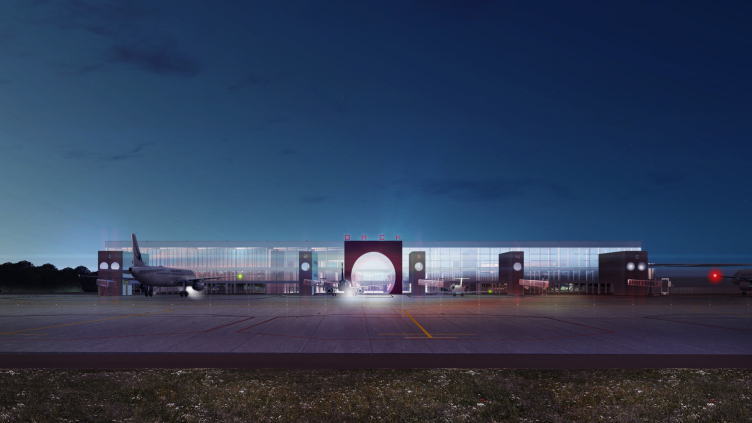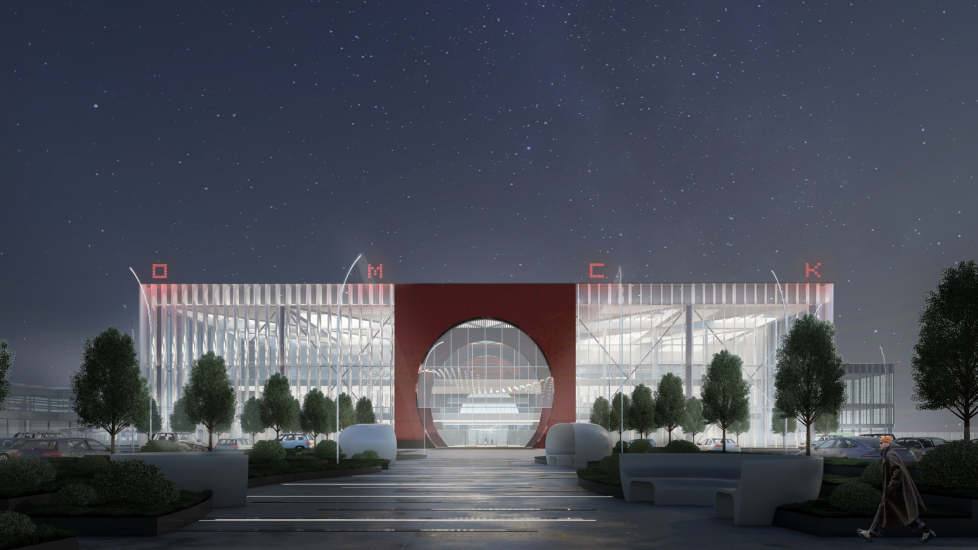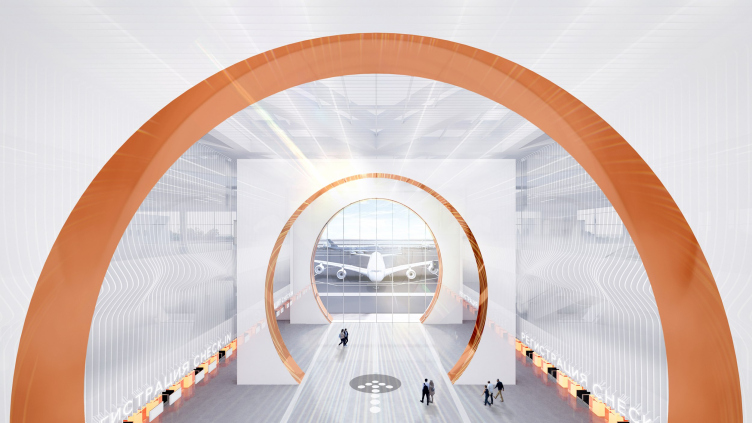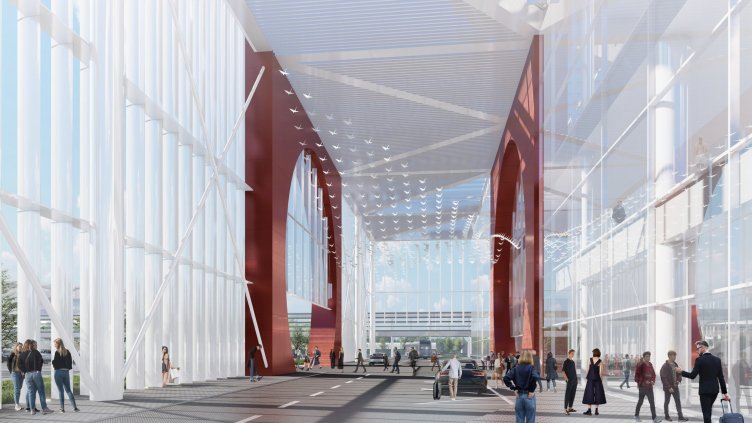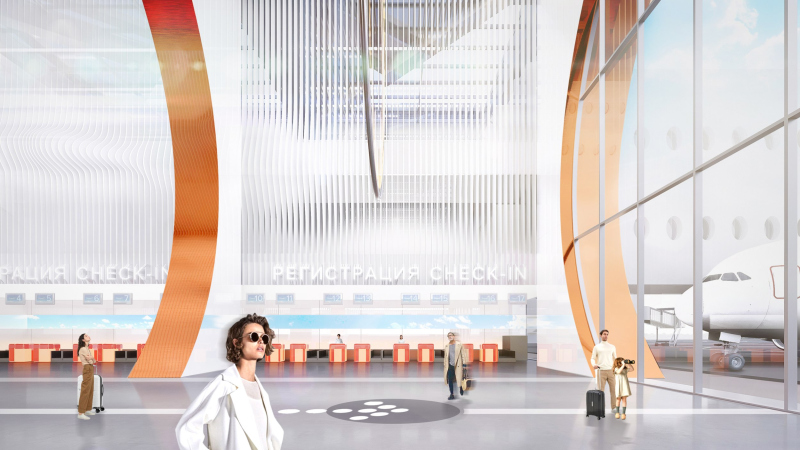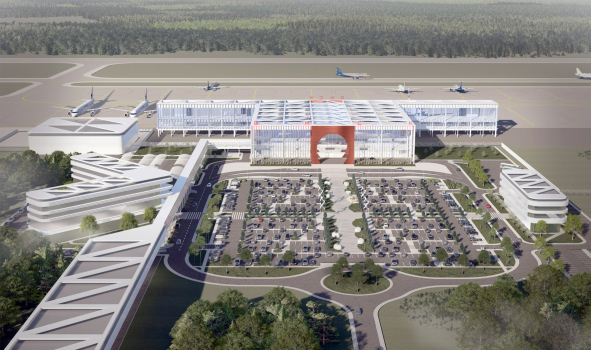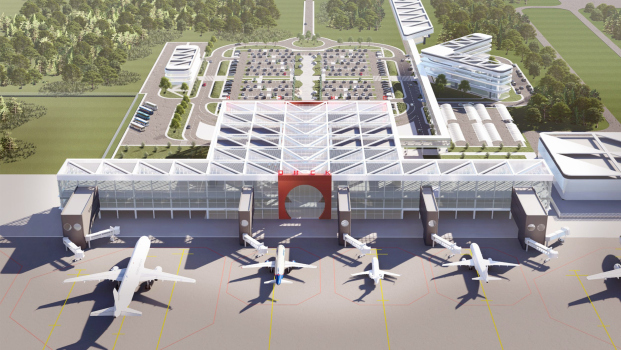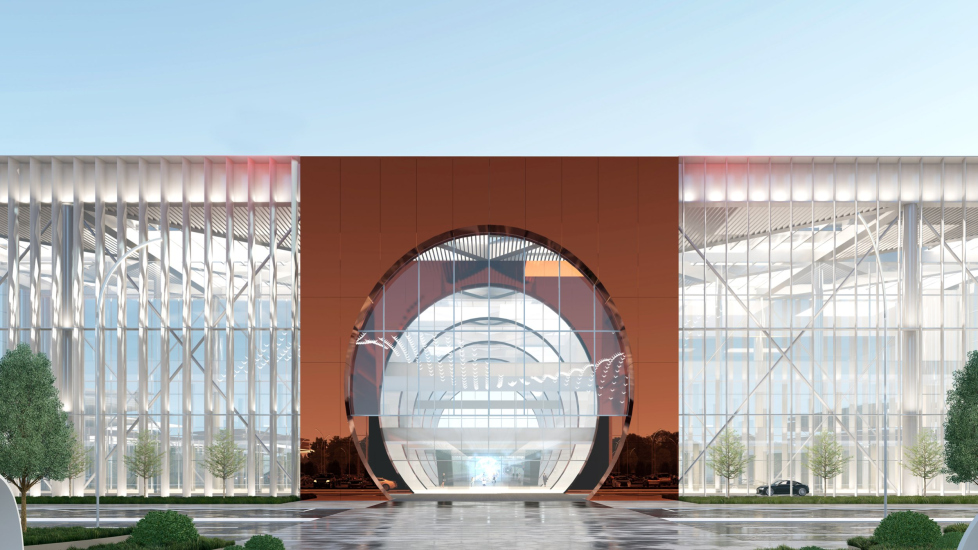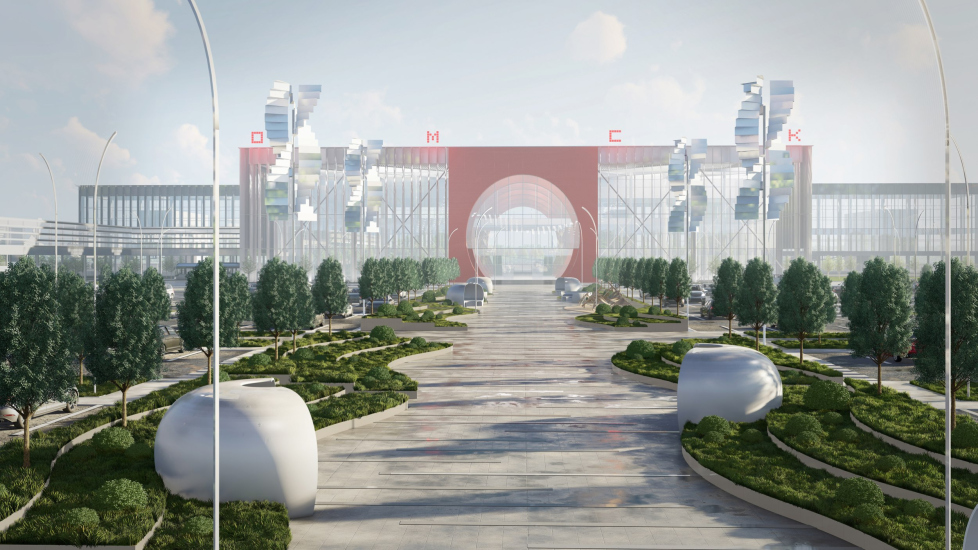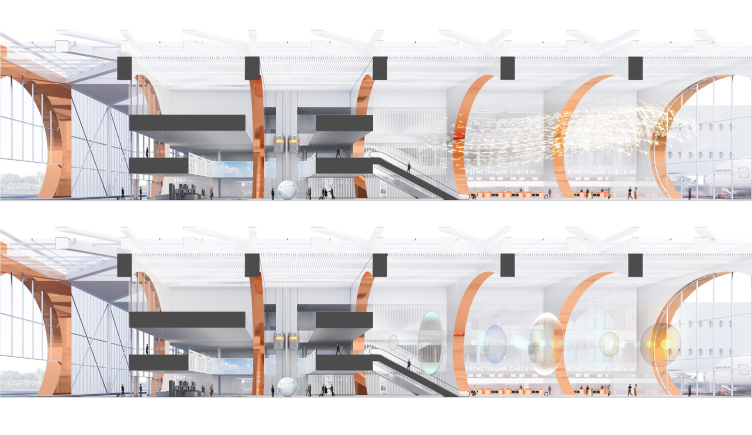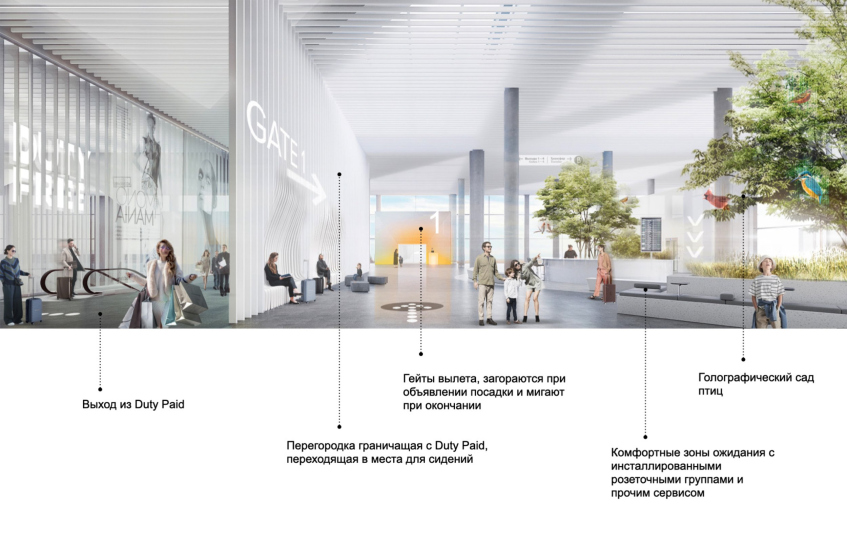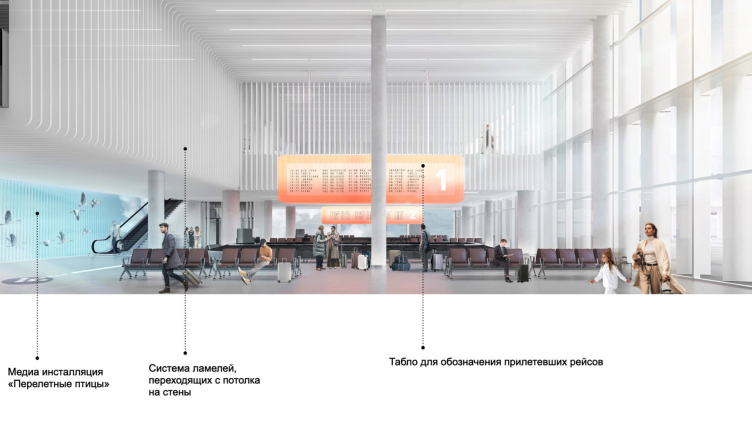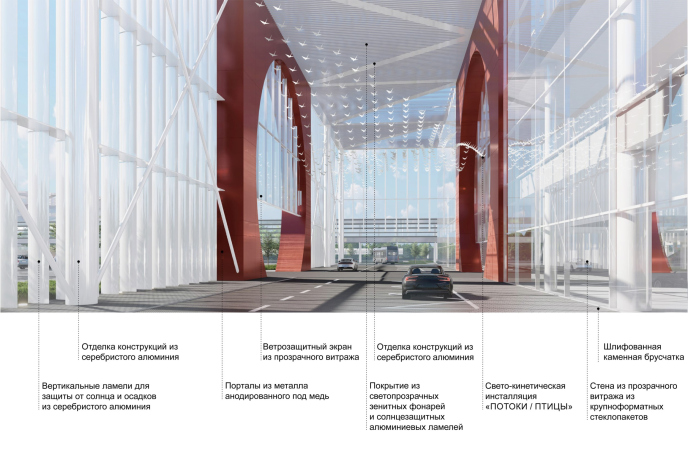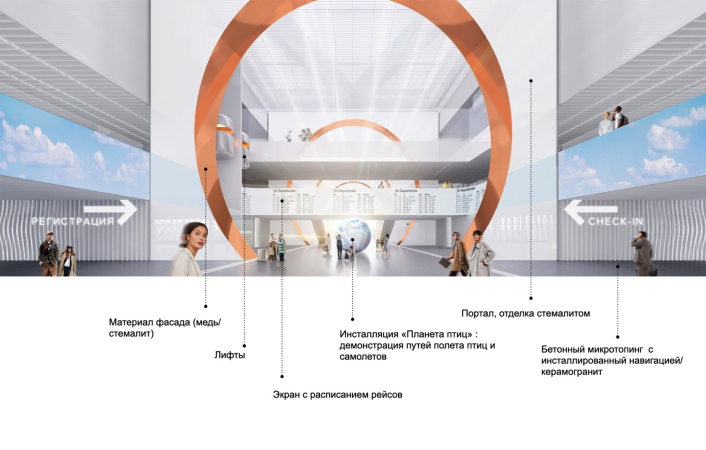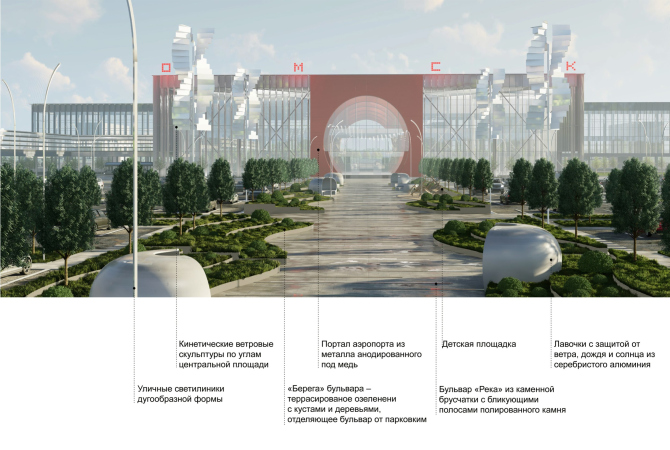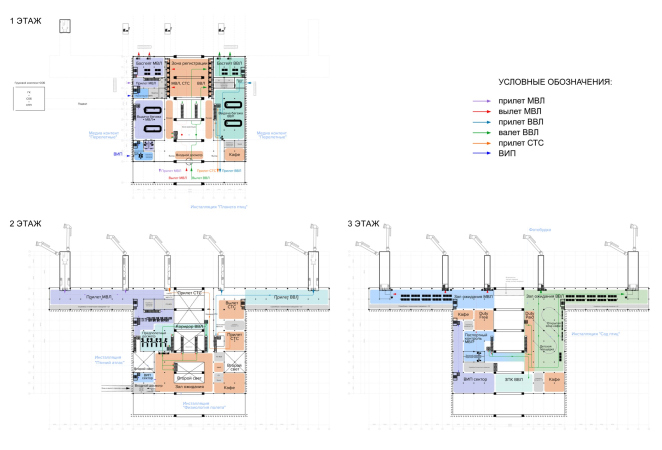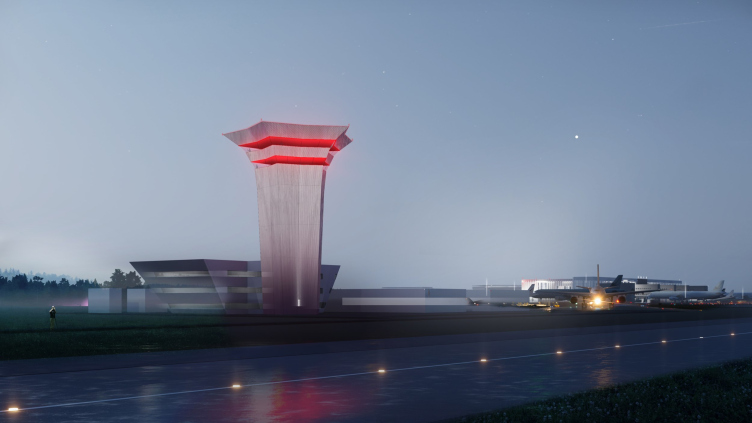The project by the team led by DNK ag is among those that made it to the “semifinals” out of the seven contenders.
Our team’s project made it to the semi-finals and we presented it in person at the Omsk City Council. It was an open and detailed discussion. The participants of the City Council emphasized the importance for the future of the airport of both a spectacular image and realistic implementation from a technical and budgetary point of view.
We improved a rather innovative terminal technology proposed by the competition organizers: the visual axis “the area in front of the terminal – the airfield” was treated as an axial space on all three levels, thus linking external and internal volumetric solutions. We proposed to “push” or “expand” the usual airport structure – this is how the image of an “innovative portal” with an active sculptural pattern in the form of circles emerged – it emphasizes the theme of rapid transition from one point to another, which in our day and age is provided by aviation. This structure is very rational and realistic, which facilitates the implementation of the project.
In addition, my colleagues and I presented the airport not only as a transportation hub, but also as a multifunctional hub, accompanying the transportation and logistics functionality with entertaining and educational content.
We improved a rather innovative terminal technology proposed by the competition organizers: the visual axis “the area in front of the terminal – the airfield” was treated as an axial space on all three levels, thus linking external and internal volumetric solutions. We proposed to “push” or “expand” the usual airport structure – this is how the image of an “innovative portal” with an active sculptural pattern in the form of circles emerged – it emphasizes the theme of rapid transition from one point to another, which in our day and age is provided by aviation. This structure is very rational and realistic, which facilitates the implementation of the project.
In addition, my colleagues and I presented the airport not only as a transportation hub, but also as a multifunctional hub, accompanying the transportation and logistics functionality with entertaining and educational content.
The project was developed by a consortium: DNK ag brought in VOX architects headed by Boris Voskoboinikov and Maria Akhremenkova, a team experienced in working with V.I.P. and other special halls of modern airports, as well as Sila Sveta, a company with experience, including international, in working with museum installations and media. So, the work was carried out at the “intersection” of different possibilities and even different disciplines and professions.
Omsk-Fedorovka Airport. Innovative portal. Competition project. Semifinal
Copyright: © DNKag / VOX / Sila Sveta
It must be said that the theme of the intersection is crucial for the project. The intersection of the Irtysh River and the Trans-Siberian Railway is depicted on the recent coat of arms of the Omsk region, approved in 2003 and in 2020 – and this coat of arms became one of the starting points for the concept.
However, according to the architects themselves, it is not the intersection that is the main theme here, and the project is ambiguous in its nature – it appeals to both streams and flights, as well as to a hyper-transition portal.
Omsk-Fedorovka Airport. Innovative portal. Competition project. Semifinal
Copyright: © DNKag / VOX / Sila Sveta
However, if we look at the architecture of the terminal proposed by the consortium, even a casual observer will easily discern the coat of arms of the region “unfolded in volume”: the intersection of two axes, the river and the highway, and the circle of the portal, resembling the outline of a fortress.
The design is based on simplicity and transparency: a rectangular volume outline, glass walls and ceiling, light aluminum columns, lamellae, and tension cables – with the strictness of the bright “hatching” of the form, everything gravitates towards dematerialization. Such a building should glow from the inside at night – not in parts, but entirely, from all sides, while during the day, it should receive – again, from all sides – plenty of natural sunlight.
The only material element in this composition of this light and semi-transparent volume is the entrance portal: a metaphorical “pivot”, integrated into the matter or space with properties different from usual, and as a result, subjected to deconstruction, and “sliced” into separate pieces
As for the portal, the architects proposed to clad it with a composite of a copper color, the first two layers entirely, and then along the inner circumference, a copper hue, with a light stemalit on the inner plane.
Omsk-Fedorovka Airport. Innovative portal. Competition project. Semifinal
Copyright: © DNKag / VOX / Sila Sveta
One of the most interesting features of this deliberately concise solution is the cold “portico”. Terminal entrances often feature large canopies, but here the first part of the volume is simply designed as a covered space, but it is situated behind the “thread” of the first façade. This creates a very convenient “entrance hub” – after all, for an airport, convenient access, comfortable taxi boarding/alighting is quite important.
From the plastique standpoint, the “layering” and dematerialization of the “portal gate” occurs precisely here, at the intersection of axes. The façade turns out to be not so much a picture as a volumetric structure, the full force of which could only be appreciated by entering this structure. Going “inside the façade”.
Omsk-Fedorovka Airport. Innovative portal. Competition project. Semifinal
Copyright: © DNKag / VOX / Sila Sveta
Here it becomes clear why the architects talk about the primacy of volumetric/spatial construction over “individual elements”.
As a result, a light, almost immaterial structure emerges, where the main thing is the section of space by planes and lines. This could create an intriguing effect of light-filled and “outlined” from inside the terminal. The image is akin to a hyper-transition – something, about which we currently don’t know much, and can only imagine and fantasize about.
The architects complement the concise form of the building with a highly developed narrative program, paying a lot of attention to both installations and edutainment modules.
In relation to the theme of flight, the architects recall the aviation factories operating in Omsk – PO “Polet” and the civil aviation plant “OZGA”, as well as… birds – the city is home to a reserve with the telling name “Bird Haven”. Hence the installations proposed by the architects: one with a flock of birds in a spiral airstream at the entrance, just as white and transparent as the facades – as well as spiral windmills in the square, the central axis of which, leading to the portal, is transformed into a “river” boulevard with winding raised edges and greenery, separating the boulevard from the parking lot on the sides.
Other types of installations are also proposed here: light lenses on the main axis, holographic birds of the region on trees, an interactive sphere, and more.
Omsk-Fedorovka Airport. Innovative portal. Competition project. Semifinal
Copyright: © DNKag / VOX / Sila Sveta
It seemed to me, however, that the most useful and pleasant innovation was the interactive gates, which light up with media illumination at the start of boarding, animating the terminal space in the most functional way possible.
Omsk-Fedorovka Airport. Innovative portal. Competition project. Semifinal
Copyright: © DNKag / VOX / Sila Sveta
A few words must be said about the edutainment modules, as they are everywhere in the project.
In the registration hall, there is an interactive sphere named “Planet of Birds”, showing the routes of birds and airplanes together. In the baggage claim area, there are media walls based on morphing principles, where one form transforms into another: an umbrella into a jellyfish, a bird into an airplane, and so on. In the pre-security zone, a bird atlas was planned – huge books with interactive pages, and in the waiting area, an installation on the topic of flight physiology, where a passenger could stand at a certain point, project their imaginary skeleton with wings onto the screen, and then save it and retrieve their winged silhouette. And finally, a “paradise garden” with holographic columns in the waiting area.
In short, you are in for a very comprehensive program indeed.
As we can see, the project is multifaceted, characterized by external simplicity, the lightness of form, and internal thoroughness, including in details.
Last but not least: there is also a mesmerizing observation tower with the effect of its upper tiers levitating.
Omsk-Fedorovka Airport. Innovative portal. Competition project. Semifinal


